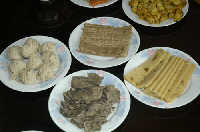|
Four Treasures of Tibetan Food
( 2005-10-27 )
 Different natural products determine different foods; different environments determine different eating manners; and different cultures determine different dietetics. Different natural products determine different foods; different environments determine different eating manners; and different cultures determine different dietetics.
Ghee, tea, tsamba, and beef and mutton are known as four treasures of Tibetan food, besides Barley wine and various milk products.
Ghee
Ghee is the extract from the milk of flocks and herds. The Tibetan way to refine ghee is very intriguing. As milk separators are not widely used in the pasture area in Southwest China's Tibet Autonomous Region, in some places Tibetan woman still refine milk manually via primitive separators.
They pour the heated milk into a big wooden bucket (called xue dong), then whip forcibly up and down (churn) many times to separate the butter from the liquid. Gradually a tier of a light yellow substance floats to the top. The women then ladle the butter and put it into a leather bag to cool, hence refined ghee.
Ghee has high nutritional value and many products, the main being buttered tea.
Tea
Tibetans revel in tea, which comes in many varieties, including the main kinds of buttered, sweet, and clear tea. In theroofof the world, no matter how hungry and tired people are, when they drink a cup of hot tea, they will sure feel full of energy. Especially, in winter with its strong winds and icy weather, a cup of tea will bring the drinker back to spring. If a visitor is uneasy because of shortness of breath, the kind Tibetans will advise him or her to drink some tea.
There is a custom to follow when drinking tea. When the host fills the bowl and offers it to the guest, the guest should take it in both hands, raise the bowl with the right hand, and, using the third finger of the left hand, dip lightly into the tea and gently flick to the sky. That means heavenly-mindedness. The guest should then flick a second and third time, which represents terra-respectfulness and Buddha-respectfulness respectively.
|

